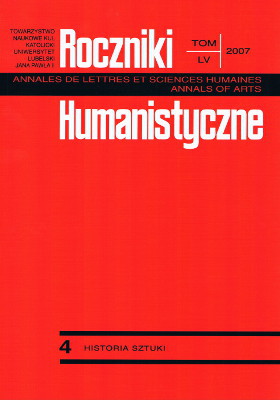The History of the Theatrical Curtain
Abstract
This paper outlines the history of the theatrical curtain that reaches back to ancient times. It also attempts to define its function and formulate a definition of this genre of art. In the Roman theatre there were two kinds of curtains: one that separated a part (Lat. siparium) or the whole of the stage from the audience (the so-called auleum). The historical evolution of the basic function of the curtain tended to enrich and elevate its meaning. The curtain should be regarded as an integral element of the theatrical interior, an individualised element and relatively autonomic. It was ornamented with woven, embroidered or painted representations. It also played a symbolic role, i.e. “the border of two worlds”: reality (on the part of the viewer) and illusive fiction (on the part of the theatrical action). The nineteenth and twentieth centuries saw some changes in the way to understand the “theatrical character”. As a result of them, the role of the curtain also changed. It became a part of the conception of stage design for a concrete performance. Eventually, the avant-garde of the twentieth century postulate to make the theatre “come closer to life”, therefore it questioned the division of the two “worlds” in general, and eliminated the curtain.
References
Bachler Karl, Gemalte Theatervorhänge in Deutschland und Österreich, München 1972.
Beare William, The Roman Stage: A Short History of Latin Drama in the Time of the Republic, London 1978.
Bieber Margarete, The History of the Greek and Roman Theatre, Princeton 1971.
courtain, [w:] Southern Richard, The Oxford Companion to the Theatre, London 1967.
Decugis Nicole, Reymond Suzanne, Le décor de théâtre en France du Moyen-Age à 1925, Paris 1953.
Furttenbach Joseph, O budowie teatru, wstęp, przekład i oprac. Z. Raszewski, Wrocław 1951.
Graefe Rainer, Vela erunt, Mainz 1979.
Król-Kaczorowska Barbara, Budynek teatru. Rozwój funkcji i form do roku 1833, Wrocław−Warszawa−Kraków 1975.
Król-Kaczorowska Barbara, Działalność teatralna J.B. Plerscha, „Pamiętnik Teatralny 1954, z. 3-4, s. 162-168.
Nagler Alois M., A Source Book in Theatrical History, New York 1952.
Nagler Alois M., Shakespeare's Stage, New Haven 1958.
Peyronnet P., Le rideau de fer de Soufflot, [w:] Louis Victor et le théâtre, Paris 1982.
Raszewski Zbigniew, Teatr na placu Krasińskich, Warszawa 1995.
rideau, [w:] Grand dictionnaire universel du XIX siècle par P. Larousse, t.XIII, Paris 1875, s. 1200 nn.
rideau, [w:] Pougin Auguste, Dictionnaire du théâtre, t. II, Paris 1885, s. 654.
Sabbatini Nicola, Pratica di fabricar scene, Ravenna 1638.
sipario, [w:] Enciclopedia dello Spettacolo, t. IX, Roma 1959, szp. 1-2.
Védier Georges, Origine et évolution de la dramaturgie néo-classique, Paris 1955.
Vorhang, [w:] Realenzyklopädie der Klassischen Altertumswissenschaft, t. I-XIX, red. A. Pauly, G. Wissowa, W. Kroll, t. II 2, Stuttgart 1949, szp. 2399 nn.
zanawies, [w:] Teatralnaja encikłopedija, red. P.A. Markow, t. II, Moskwa 1963, szp. 737.
Zielske Harald, Deutsche Theaterbauten bis zum zweiten Weltkrieg. Typologisch-historische Dokumentation einer Baugattung, Berlin 1971.
Copyright (c) 2007 Roczniki Humanistyczne

This work is licensed under a Creative Commons Attribution-NonCommercial-NoDerivatives 4.0 International License.





